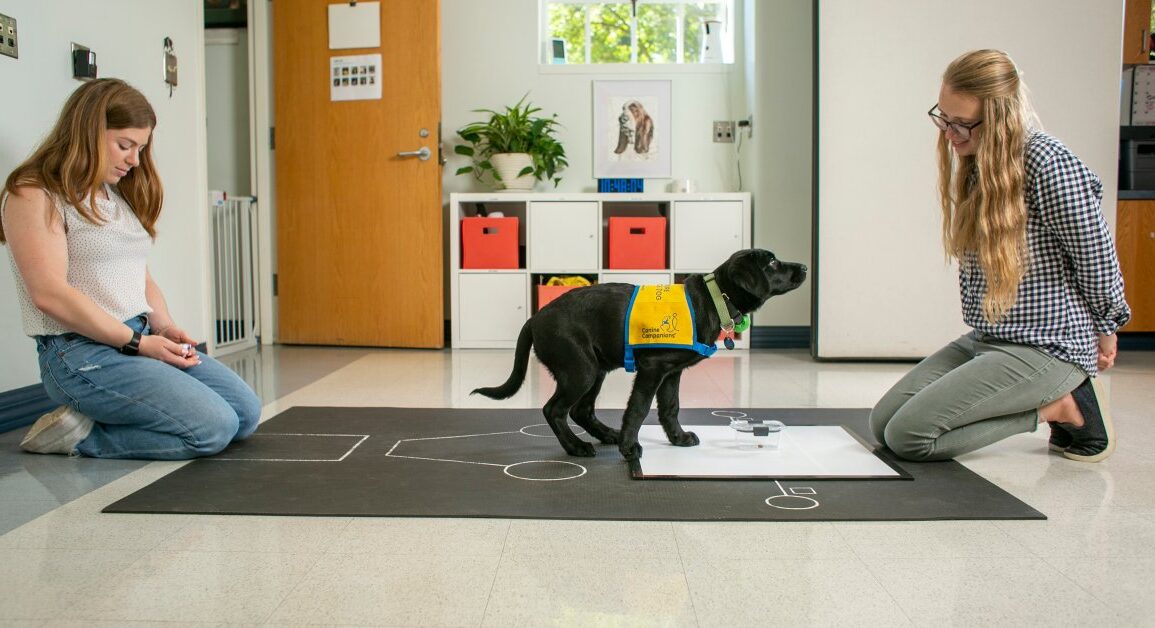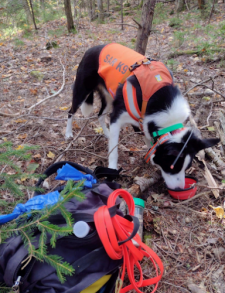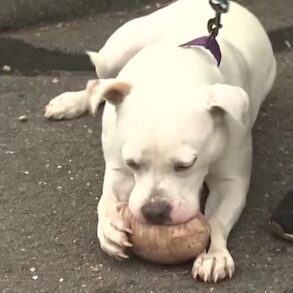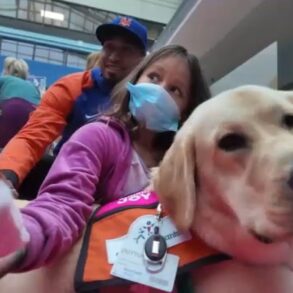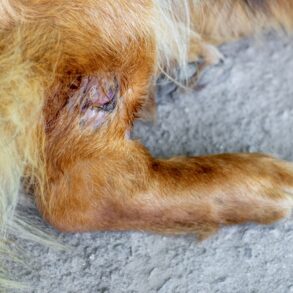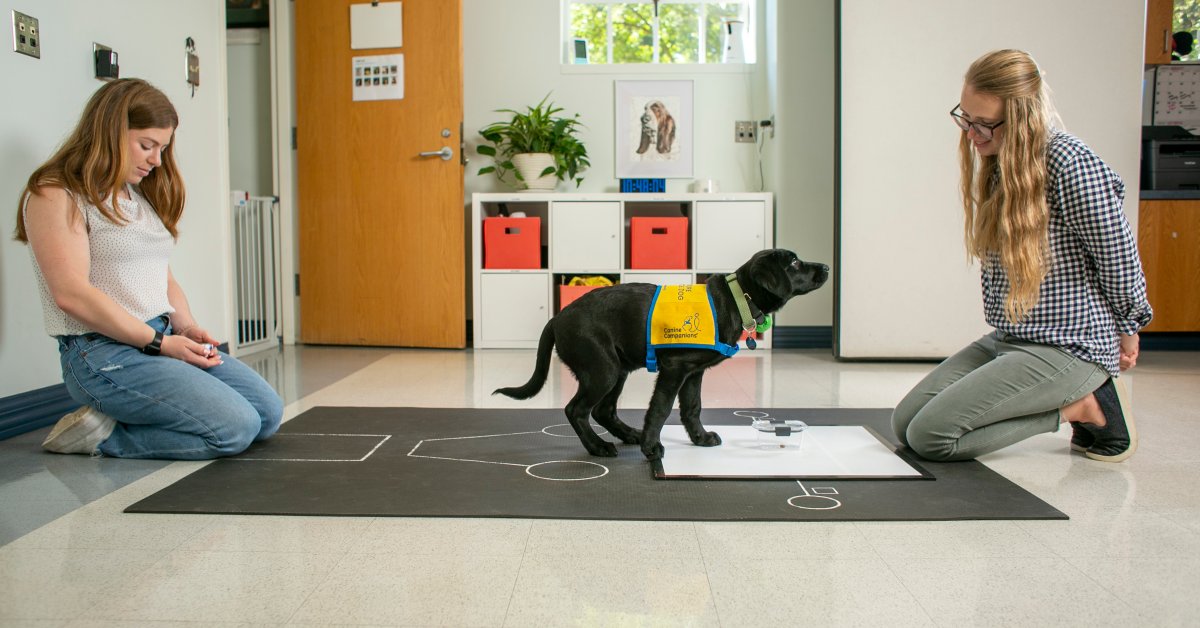
If you want to get your oxytocin flowing, there’s no better place to do it than in the bright, sunny play space on the campus of Duke University where Brian Hare and Vanessa Woods spend their days. Oxytocin, nicknamed the cuddle chemical, is a hormone produced by the hypothalamus that gives rise to feelings of love, warmth, altruism, and caring; it spikes in the bloodstreams of lovers, friends, and, especially, new mothers and their babies—and Hare and Woods fairly traffic in the stuff. Hare is a professor of evolutionary anthropology, psychology, and neuroscience; Woods, his wife, is an author and science journalist, and together they run Duke University’s Puppy Kindergarten, a 12-week program in which 10 puppies at a time, beginning at 8 weeks old, spend their days going through training and evaluation to determine which ones will make the best service dogs.
When the puppies are out for walks on campus, crowds gather, phone cameras flash, and students drop to the ground for a hug or a cuddle. Inside the kindergarten, up to 100 student volunteers sign up every semester to work two-hour shifts brushing puppy teeth, wiping sleep from puppy eyes, and scouring grass for overlooked poop—but it’s puppy poop, so that’s OK. The puppies love the people, the people love the puppies, and while it’s reductive in the extreme to distill the canine-human bond to nothing more than hormonal chemistry, there’s no denying that oxytocin is the rocket fuel of the relationship.
One 2015 study conducted at Azabu University in Japan found that when dogs and their owners spend even a few minutes gazing into each other’s eyes, oxytocin levels spike in the dogs by 130% and in the humans by a staggering 300%. Hare’s and Woods’ work, which they write about in their new book, The Puppy Kindergarten, has revealed that higher oxytocin in the dogs actually seems to help them understand human gestures like pointing.
“Dogs that have elevated oxytocin actually are better at understanding our intent,” says Hare. “They make more eye contact and are more attentive.”
That has led Hare and Woods to play a simple but powerful game with their puppies, one that not only helps them determine which are best suited to which kinds of work when they grow up, but also strengthens the bond between the animals and their humans. It’s a game that families can try with their puppies, too.
The benefits of seeking help
Hare, Woods, or a student volunteer begins the game by putting a treat in a small, clear food storage container and presenting it to the puppies—who happily snap up the food. Next, the food will be presented in the same box, but with an unlatched top; the puppies knock off the top and gobble up the food again. Finally, the experiment will be repeated, but this time latches on the top of the box will be snapped shut and locked.
The puppies typically respond one of three ways: Some briefly try to snag the food and then give up. Some will be, well, dogged, mouthing and batting and tipping the box, trying to get the top unlocked. Others try a different strategy—turning to the human experimenter and making eye contact, a clear signal that they want help.
“I always joke that the dog looks up and says, ‘Hey, you know you’re the one that has a thumb; help me out here,’” says Hare.
Dogs try other ways to enlist human assistance, too—mostly barking or nudging—but eye contact is the go-to device. That pays dividends. Hare and Woods have found that puppies between eight and 20 weeks old who play the game for just five minutes at a time, once every two weeks, make about twice as much eye contact with their humans as puppies who don’t play the game, or who do play it but either give up or persist with the box without seeking help.
“Owners who have dogs who make a lot of eye contact report being happier with their relationship with their dog,” says Woods. “Dogs who make a lot of eye contact also get adopted out of shelters faster.”
Other members of the canid family—wolves, jackals, foxes, dingoes—do not seek human assistance the same way. Hare and Woods have tried the food experiment with wolf pups with very different results. “Wolf puppies don’t make as much eye contact with humans—and they, in fact, don’t make any eye contact, basically.”
Survival of the cutest
It’s not just behavioral evolution that has brought out this trait in domesticated dogs: It’s physical evolution, too. Dogs have a facial muscle near the eye called the AU101 that pulls the lids in such a way to reveal more of the sclera—or white—of the eye. Seeing sclera on the face of another person, Hare says, is one way babies who are just a few months old identify another living creature as being human. When dogs expose their sclera to us, we respond powerfully.
“They make that sort of adorable, irresistible, guilty eye look,” says Hare.
In Puppy Kindergarten, the box game reveals a lot about a dog’s temperament and future. Puppies who don’t seek help—who just keep going and going at the locked box—often excel at detecting bombs and looking for buried survivors at the site of terrorist attacks or natural disasters.
“Persistence is a good marker for this kind of work,” says Hare. “The most successful detector dogs are the ones who can work off-lead. You let them go search a space without you being there.”
Dogs who seek help and make a lot of eye contact, by contrast, are better at offering help in return, succeeding as service dogs for the blind or housebound or people suffering with post-traumatic stress disorder.
“If you’re going to look up and make eye contact, you’re going to be more likely to see when someone’s asking you, ‘Hey, I dropped my keys or can you open the door for me,’” Hare says.
The vast majority of the 470 million pet dogs worldwide will never be pressed into this kind of service, of course. They will engage, instead, in work of the heart: giving love, receiving love, and doing their part in an interspecies dance that has been going on for some 23,000 years, when an unknown wild dog and an unknown hunter-gatherer first locked eyes. The romance has endured ever since.
This post was originally published on this site be sure to check out more of their content.




